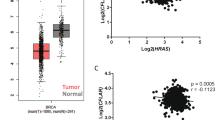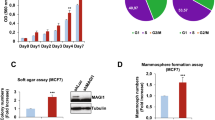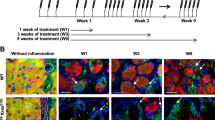Abstract
The Gab2 docking protein is a target of several oncogenic protein tyrosine kinases and potentiates activation of the Ras/extracellular signal regulated kinase and phosphatidylinositol 3-kinase (PI3-kinase) pathways. Since Gab2 is phosphorylated by c-Src, and both proteins are overexpressed in breast cancers, we have determined the biological consequences of their co-expression in the immortalized human mammary epithelial cell line MCF-10A. While overexpression of c-Src did not affect acinar morphogenesis or growth factor dependence in three-dimensional culture, c-Src co-operated with Gab2 to promote epidermal growth factor (EGF)-independent acinar growth. In contrast, expression of v-Src or the activated mutant c-SrcY527F led to a spectrum of aberrant phenotypes ranging from spheroids with incomplete luminal clearance to highly disrupted, dispersed structures. Gab2 co-expression shifted the phenotypic distribution towards the dispersed phenotype, an effect not observed with a Gab2 mutant unable to bind the p85 subunit of PI3-kinase (Gab2Δp85). In v-Src-expressing cells, Gab2, but not Gab2Δp85, significantly decreased E-cadherin adhesive strength without altering its surface expression. Gab2 associated with E-cadherin in the presence and absence of v-Src, indicating that the ability of Gab2 to weaken the strength of cell–cell contacts may reflect enhanced activation of PI3-kinase at adherens junctions. Gab2 also increased migration and invasion of these cells in transwell assays, but these effects were p85-independent. Overall, these findings demonstrate a novel mechanism whereby Gab2 may promote metastatic spread and indicate that Gab2 may play several roles during breast cancer progression.
This is a preview of subscription content, access via your institution
Access options
Subscribe to this journal
Receive 50 print issues and online access
$259.00 per year
only $5.18 per issue
Buy this article
- Purchase on Springer Link
- Instant access to full article PDF
Prices may be subject to local taxes which are calculated during checkout








Similar content being viewed by others

References
Bentires-Alj M, Gil SG, Chan R, Wang ZC, Wang Y, Imanaka N et al. (2006). A role for the scaffolding adapter GAB2 in breast cancer. Nat Med 12: 114–121.
Brieher WM, Gumbiner BM . (1994). Regulation of C-cadherin function during activin induced morphogenesis of Xenopus animal caps. J Cell Biol 126: 519–527.
Brummer T, Schramek D, Hayes VM, Bennett HL, Caldon CE, Musgrove EA et al. (2006). Increased proliferation and altered growth factor dependence of human mammary epithelial cells overexpressing the Gab2 docking protein. J Biol Chem 281: 626–637.
Clevenger CV . (2004). Roles and regulation of stat family transcription factors in human breast cancer. Am J Pathol 165: 1449–1460.
Daly RJ, Gu H, Parmar J, Malaney S, Lyons RJ, Kairouz R et al. (2002). The docking protein Gab2 is overexpressed and estrogen regulated in human breast cancer. Oncogene 21: 5175–5181.
Debnath J, Muthuswamy SK, Brugge JS . (2003a). Morphogenesis and oncogenesis of MCF-10A mammary epithelial acini grown in three-dimensional basement membrane cultures. Methods 30: 256–268.
Debnath J, Walker SJ, Brugge JS . (2003b). Akt activation disrupts mammary acinar architecture and enhances proliferation in an mTOR-dependent manner. J Cell Biol 163: 315–326.
Frame MC . (2004). Newest findings on the oldest oncogene; how activated Src does it. J Cell Sci 117: 989–998.
Gonzalez L, Agullo-Ortuno MT, Garcia-Martinez JM, Calcabrini A, Gamallo C, Palacios J et al. (2006). Role of c-Src in human MCF7 breast cancer cell tumorigenesis. J Biol Chem 281: 20851–20864.
Grille SJ, Bellacosa A, Upson J, Klein-Szanto AJ, van Roy F, Lee-Kwon W et al. (2003). The protein kinase Akt induces epithelial mesenchymal transition and promotes enhanced motility and invasiveness of squamous cell carcinoma lines. Cancer Res 63: 2172–2178.
Gu H, Neel BG . (2003). The ‘Gab’ in signal transduction. Trends Cell Biol 13: 122–130.
Guan KL, Figueroa C, Brtva TR, Zhu T, Taylor J, Barber TD et al. (2000). Negative regulation of the serine/threonine kinase B-Raf by Akt. J Biol Chem 275: 27354–27359.
Huang E, Cheng SH, Dressman H, Pittman J, Tsou MH, Horng CF et al. (2003). Gene expression predictors of breast cancer outcomes. Lancet 361: 1590–1596.
Irby RB, Yeatman TJ . (2000). Role of Src expression and activation in human cancer. Oncogene 19: 5636–5642.
Irie HY, Pearline RV, Grueneberg D, Hsia M, Ravichandran P, Kothari N et al. (2005). Distinct roles of Akt1 and Akt2 in regulating cell migration and epithelial-mesenchymal transition. J Cell Biol 171: 1023–1034.
Ischenko I, Petrenko O, Gu H, Hayman MJ . (2003). Scaffolding protein Gab2 mediates fibroblast transformation by the SEA tyrosine kinase. Oncogene 22: 6311–6318.
Janes PW, Daly RJ, deFazio A, Sutherland RL . (1994). Activation of the Ras signalling pathway in human breast cancer cells overexpressing erbB-2. Oncogene 9: 3601–3608.
Kassenbrock CK, Hunter S, Garl P, Johnson GL, Anderson SM . (2002). Inhibition of Src family kinases blocks epidermal growth factor (EGF)-induced activation of Akt, phosphorylation of c-Cbl, and ubiquitination of the EGF receptor. J Biol Chem 277: 24967–24975.
Ke Y, Wu D, Princen F, Nguyen T, Pang Y, Lesperance J et al. (2007). Role of Gab2 in mammary tumorigenesis and metastasis. Oncogene 26: 4951–4960.
Kong M, Mounier C, Dumas V, Posner BI . (2003). Epidermal growth factor-induced DNA synthesis. Key role for Src phosphorylation of the docking protein Gab2. J Biol Chem 278: 5837–5844.
Kotelevets L, van Hengel J, Bruyneel E, Mareel M, van Roy F, Chastre E . (2001). The lipid phosphatase activity of PTEN is critical for stabilizing intercellular junctions and reverting invasiveness. J Cell Biol 155: 1129–1135.
Kotelevets L, van Hengel J, Bruyneel E, Mareel M, van Roy F, Chastre E . (2005). Implication of the MAGI-1b/PTEN signalosome in stabilization of adherens junctions and suppression of invasiveness. FASEB J 19: 115–117.
Kovacs EM, Ali RG, McCormack AJ, Yap AS . (2002). E-cadherin homophilic ligation directly signals through Rac and phosphatidylinositol 3-kinase to regulate adhesive contacts. J Biol Chem 277: 6708–6718.
Lu Y, Yu Q, Liu JH, Zhang J, Wang H, Koul D et al. (2003). Src family protein-tyrosine kinases alter the function of PTEN to regulate phosphatidylinositol 3-kinase/AKT cascades. J Biol Chem 278: 40057–40066.
Lynch DK, Daly RJ . (2002). PKB-mediated negative feedback tightly regulates mitogenic signalling via Gab2. EMBO J 21: 72–82.
Mege RM, Gavard J, Lambert M . (2006). Regulation of cell-cell junctions by the cytoskeleton. Curr Opin Cell Biol 18: 541–548.
Mohi MG, Williams IR, Dearolf CR, Chan G, Kutok JL, Cohen S et al. (2005). Prognostic, therapeutic, and mechanistic implications of a mouse model of leukemia evoked by Shp2 (PTPN11) mutations. Cancer Cell 7: 179–191.
Nishida K, Yoshida Y, Itoh M, Fukada T, Ohtani T, Shirogane T et al. (1999). Gab-family adapter proteins act downstream of cytokine and growth factor receptors and T- and B-cell antigen receptors. Blood 93: 1809–1816.
Nyga R, Pecquet C, Harir N, Gu H, Dhennin-Duthille I, Regnier A et al. (2005). Activated STAT5 proteins induce activation of the PI 3-kinase/Akt and Ras/MAPK pathways via the Gab2 scaffolding adapter. Biochem J 390: 359–366.
Pang JH, Kraemer A, Stehbens SJ, Frame MC, Yap AS . (2005). Recruitment of phosphoinositide 3-kinase defines a positive contribution of tyrosine kinase signaling to E-cadherin function. J Biol Chem 280: 3043–3050.
Podar K, Mostoslavsky G, Sattler M, Tai YT, Hayashi T, Catley LP et al. (2004). Critical role for hematopoietic cell kinase (Hck)-mediated phosphorylation of Gab1 and Gab2 docking proteins in interleukin 6-induced proliferation and survival of multiple myeloma cells. J Biol Chem 279: 21658–21665.
Ren Y, Meng S, Mei L, Zhao ZJ, Jove R, Wu J . (2004). Roles of Gab1 and SHP2 in paxillin tyrosine dephosphorylation and Src activation in response to epidermal growth factor. J Biol Chem 279: 8497–8505.
Reynolds AB, Vila J, Lansing TJ, Potts WM, Weber MJ, Parsons JT . (1987). Activation of the oncogenic potential of the avian cellular Src protein by specific structural alteration of the carboxy terminus. EMBO J 6: 2359–2364.
Sattler M, Mohi MG, Pride YB, Quinnan LR, Malouf NA, Podar K et al. (2002). Critical role for Gab2 in transformation by BCR/ABL. Cancer Cell 1: 479–492.
Shewan AM, Maddugoda M, Kraemer A, Stehbens SJ, Verma S, Kovacs EM et al. (2005). Myosin 2 is a key Rho kinase target necessary for the local concentration of E-cadherin at cell-cell contacts. Mol Biol Cell 16: 4531–4542.
Shore EM, Nelson WJ . (1991). Biosynthesis of the cell adhesion molecule uvomorulin (E-cadherin) in Madin-Darby canine kidney epithelial cells. J Biol Chem 266: 19672–19680.
Verma S, Shewan AM, Scott JA, Helwani FM, den Elzen NR, Miki H et al. (2004). Arp2/3 activity is necessary for efficient formation of E-cadherin adhesive contacts. J Biol Chem 279: 34062–34070.
Vogelmann R, Nguyen-Tat MD, Giehl K, Adler G, Wedlich D, Menke A . (2005). TGFbeta-induced downregulation of E-cadherin-based cell-cell adhesion depends on PI3-kinase and PTEN. J Cell Sci 118: 4901–4912.
Wada T, Nakashima T, Oliveira-dos-Santos AJ, Gasser J, Hara H, Schett G et al. (2005). The molecular scaffold Gab2 is a crucial component of RANK signaling and osteoclastogenesis. Nat Med 11: 394–399.
Wang FM, Liu HQ, Liu SR, Tang SP, Yang L, Feng GS . (2005). SHP-2 promoting migration and metastasis of MCF-7 with loss of E-cadherin, dephosphorylation of FAK and secretion of MMP-9 induced by IL-1beta in vivo and in vitro. Breast Cancer Res Treat 89: 5–14.
Wrobel CN, Debnath J, Lin E, Beausoleil S, Roussel MF, Brugge JS . (2004). Autocrine CSF-1R activation promotes Src-dependent disruption of mammary epithelial architecture. J Cell Biol 165: 263–273.
Yamasaki S, Nishida K, Hibi M, Sakuma M, Shiina R, Takeuchi A et al. (2001). Docking protein Gab2 is phosphorylated by ZAP-70 and negatively regulates T cell receptor signaling by recruitment of inhibitory molecules. J Biol Chem 276: 45175–45183.
Yu M, Lowell CA, Neel BG, Gu H . (2006). Scaffolding adapter Grb2-associated binder 2 requires Syk to transmit signals from FcepsilonRI. J Immunol 176: 2421–2429.
Yu WM, Hawley TS, Hawley RG, Qu CK . (2002). Role of the docking protein Gab2 in beta(1)-integrin signaling pathway-mediated hematopoietic cell adhesion and migration. Blood 99: 2351–2359.
Acknowledgements
This work was supported by Department of Defense Breast Cancer Research Program Grant DAMD17-00-1-0251 and the National Health and Medical Research Council of Australia. HLB and AJ are the recipients of a Australian Postgraduate Award and NHMRC Dora Lush Biomedical Postgraduate Research Scholarship, respectively.
Author information
Authors and Affiliations
Corresponding author
Rights and permissions
About this article
Cite this article
Bennett, H., Brummer, T., Jeanes, A. et al. Gab2 and Src co-operate in human mammary epithelial cells to promote growth factor independence and disruption of acinar morphogenesis. Oncogene 27, 2693–2704 (2008). https://doi.org/10.1038/sj.onc.1210928
Received:
Revised:
Accepted:
Published:
Issue Date:
DOI: https://doi.org/10.1038/sj.onc.1210928
Keywords
This article is cited by
-
The pseudokinase NRBP1 activates Rac1/Cdc42 via P-Rex1 to drive oncogenic signalling in triple-negative breast cancer
Oncogene (2023)
-
Characterization of the Src-regulated kinome identifies SGK1 as a key mediator of Src-induced transformation
Nature Communications (2019)
-
BRAF inhibition upregulates a variety of receptor tyrosine kinases and their downstream effector Gab2 in colorectal cancer cell lines
Oncogene (2018)
-
Alterations of Gab2 signalling complexes in imatinib and dasatinib treated chronic myeloid leukaemia cells
Cell Communication and Signaling (2013)
-
GAB2 induces tumor angiogenesis in NRAS-driven melanoma
Oncogene (2013)


